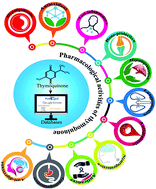Therapeutic perspectives of the black cumin component thymoquinone: A review
Abstract
The dietary phytochemical thymoquinone (TQ), belonging to the family of quinones, mainly obtained from the black and angular seeds of Nigella sativa, is one of the promising monoterpenoid hydrocarbons, which has been receiving massive attention for its therapeutic potential and pharmacological properties. It plays an important role as a chemopreventive and therapeutic agent in the treatment of various diseases and illnesses. The aim of this review is to present a summary of the most recent literature pertaining to the use of TQ for the prevention and treatment of various diseases along with possible mechanisms of action, and the potential use of this natural product as a complementary or alternative medicine. Research findings indicated that TQ exhibits numerous pharmacological activities including antioxidant, anti-inflammatory, cardioprotective, hepatoprotective, antidiabetic, neuroprotective, and anticancer, among others. Conclusions of this review on the therapeutic aspects of TQ highlight the medicinal and folk values of this compound against various diseases and ailments. In short, TQ could be a novel drug in clinical trials, as we hope.

- This article is part of the themed collection: Recent Review Articles


 Please wait while we load your content...
Please wait while we load your content...